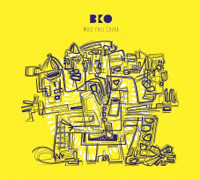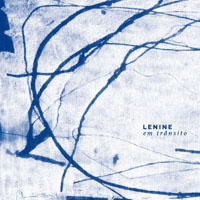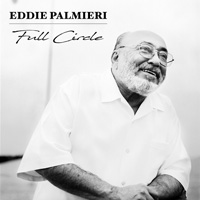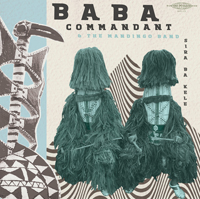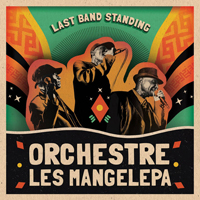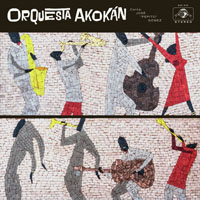The Top Eight Reissues of 2018
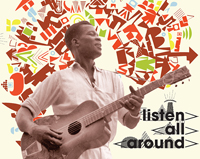
|
LISTEN ALL AROUND (Dust to Digital DTD52)
A new double-CD of 47 tracks recorded by Hugh Tracey is one of the mind-blowing discoveries that thrills fans of African roots music, like your reporter. Of course there are a few duplications from already reissued CDs, but the consistently outstanding quality of the music, and informative liner notes by Alex Perullo, make this worth every penny, especially given the durable book-format packaging from Dust to Digital. The subtitle is "1950s popular music from the Congo, Tanganyika, Zanzibar and Kenya." Hugh Tracey made many trips from his base in South Africa to record in the field, streets and social clubs, taking along his wife Peggy, Douglas Rex, a sound engineer, and two drivers, one a Swazi speaker the other who spoke Ndau. To help finance his travels he deliberately sought commercial acts that he knew Gallo Records could market, but also looked for good musicians in any genre to capture live. The songs were not only popular in other parts of Africa but of course were covered by American folkies in the 50s and 60s so that Jean Bosco Mwenda and one or two others had a global impact. (Pete Seeger brought Jean Bosco to the Newport Folk Festival in 1969.) Like his younger French counterpart, Charles Duvelle, Tracey's earliest published records won prizes and garnered attention. My cherished Decca 10-inches proudly proclaim "The African Music Society's Best Music for 1952" (leading off with "Masanga"); the following year there were two albums issued as winners of the Osborne Award (Decca LD9221-2). The musicians Tracey recorded quite often did not want any part of traditional music with thumb pianos and zithers, but were drawn to Cuban son, American jazz and country, European ballroom and military marches -- the prime reason being that in modern dance music you got to dance close to your partner. Tracey's first sortie in 1950 took him to Southern Rhodesia (now Zimbabwe), Nyasaland (Malawi), Tanganyika (Tanzania), Zanzibar, Uganda and Mozambique. He made over 1000 recordings and then edited and archived them. With funding from the Ford Foundation, he issued a series of 210 [sic!] LP records called The Sound of Africa between 1958 and 1963, and provided sets to 60 academic libraries. Three commercial companies, Gallo and Tropik (South Africa), and Decca (London), repackaged some of the material. The Jimmy Rogers praise song by Kipsigis girls, "Chemirocha," is here, and Jean Bosco with "Mwenda tulikwenda," and you probably have or have heard "Mama Josefina" by Patrice Ilunga and Victor Misomba, with their two guitars in open tuning accompanied by a tapped bottle. Otherwise there is little duplication with the excellent series on Sharp Wood that even includes The Very Best of Hugh Tracey and Origins of Guitar Music in Southern Congo and Northern Zambia. Perullo has found interesting parallels to Ghanaian Highlife (a restrained Coast Social Orchestra, trying to stay laid back as they romp through a cover of "Rolling Ball") and a cover of "Lamento Esclavo" by Rico's Creole Band (GV26), done here by Dar Es Salaam Jazz band. The ECO African Band gives us "Doa jeupe," a "Peanut Vendor" cover on kazoo (though not identified as such) from 1952. There are three cuts from Salum Seliman's Brass Band -- I swear the chorus to "Shukurani (give thanks)" is Woody Guthrie's "This land is your land," but Alex Perullo only says it was a popular East African song. The last cut by Ombiza Charles, "Tulale Ngonga Imelia (The Time Has Come to Sleep)" is another gem, and I thought it might be on one of the Sharp Wood issues, where I only found two other songs by him, so clearly there's more gold in those archives. The sequencing is didactic without being pedantic, in fact the flow of the music is fantastic. Tracey was not patronizing, he appreciated good music and sought out outstanding performers. Yet he personally found some of the town music tiresome with its emphasis on sex n drugs and rock n roll, but he knew that was what Gallo wanted and lamented that they were not as interested in high quality folk music. This set presents a broad spectrum of musical styles and was culled from a larger selection made by ILAM archivist Elijah Madiba who also dug through files and found photos and notes that were thought lost. One major problem is the liner notes were printed before they finalized the track sequence so there is confusion about a few of the songs. Nevertheless, it's a wonderful reach into the history of the music and is as fresh now as it was 70 years ago. · |
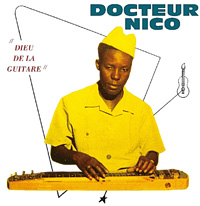
|
DOCTEUR NICO
DIEU DE LA GUITARE (Planet Ilunga 4)
Planet Ilunga previously published discs devoted to Le Grand Kalle, Rock-a-mambo and early Franco, so it is fitting they should turn to the next great name in that pantheon: Nicolas Kasanda, a.k.a. Docteur Nico, an artist who started out in Opika studios as a teenager and grew to be arguably the most innovative and original guitarist to come out of Congo. Nico's style is different from Franco's -- his nearest rival -- being more fluid, more ethereal, less rooted in the musical structure of the piece. While Franco was the Sorcerer of the guitar, Nico was considered the God. But rather than continue comparing apples and oranges, let us listen to Nico. I do not have the resources to pursue the rare early 78s, or even some of the Nico 45s that regularly come up on Ebay with asking price of $50 or more. I have lucked out and found one or two but my collection is mainly based on the 20 or so LPs released or distributed by Sonodisc and the ten reissued CDs which tended to muddy the waters with mislabelled or substandard additions (Between them they cover about a quarter of Nico's mature recordings as band-leader). I have tried to clarify the issue with two editions of my Discography of Dr Nico which lists most of the 134 singles on the VITA label from 1963 on and the subsequent 142 singles on Sukisa from 1966 to 1975. Ngoma, African, ASL & Decca/Congo also reissued these singles, though occasionally singles came out on other labels such as Philips or Super Contact.
This album surveys the complete history, particularly the obscure early work of Nico. After Opika closed in 1957 most of the artists moved to Esengo: Nico was just out of his teens but already the star guitarist on the label so he plugged into different combos for recording. Apparently one of his greatest recordings from this period is "Telegramme d'amour" -- this is a qualified statement as no one seems to have it, or at least be willing to share it. This reinforces the point that this cultural patrimony has been seriously mishandled by the French and Belgian labels who had the rights to publish and promote the music. They got it cheaply, in nefarious deals with the likes of Roger Izeidi and Rochereau, and (easy come, easy go) have discarded or mislaid tapes or master discs. Nico's own tapes were lost when his studio mysteriously burned down after he refused to record a praise song for the dictator Mobutu.
This overview starts from simple early studio work, with jagged guitar, upright bass, congas and claves, maracas, even a 1940s Solovox organ with its farty warmth. Among the miscellaneous rumbas we hear one outstanding folklore-based piece, "Tshiandanda Ngalula" which foreshadows some of Nico's later recordings (usually penned by his brother) that have the mutuashi beat of Kasai as their basis. Outstanding sidemen include clarinetist and sax player Jean-Serge Essous.
After his work at Esengo with African Jazz, Nico and his brother Dechaud broke away and formed African Jazz Aile Nico in 1961 but then returned to Kabasele briefly. By 1962 Nico was standing out prominently with tracks like "Kamulanga," reprised here, and the "shimmering" effect on "I'm sorry," another of his merengues. Roger Izeidi ran a hotel called the Blue Bar in Kinshasa and the German ambassador heard them and asked them to come and play in Germany. Kabasele did not make the trip, as he was going on his honeymoon, and he faxed them a request that they not use the African Jazz name, and this is when the group became African Fiesta. While a lot of Congolese bands used "Jazz" in their name, Fracasseur (the group's drummer) noted that Europeans who heard them knew they played rumba and thought it a bit absurd to call themselves jazz bands. Fracasseur was himself a good jazz drummer, having started out as conga player in a trio with Manu Dibango, then says (in conversation with film-maker Alan Brain) he was the first Congolese to play trap drums (but only in bars). Kalle's protég�é Rochereau was now the lead singer and the repertoire leaned heavily on the cha-chas and son-montunos of Orquesta Aragón, Enrique Jorrín, Sonora Matancera and so on.
Side Three focuses on the Vita years, 1963-6, when Nico, Roger Izeidi and Rochereau led the group together. From these 270 songs, Bart has selected a good cross section: a bolero "Moto abungaka" has lush guitar over a tropical guiro, conga and maraca beat; "Rose mosica" also shows the complex riffing of Nico in a Mujos song with Tabu Ley on harmony; "Merengue Matthieu," another rarity, has horn counterpoint to needlework-like guitar; "Vita Matata" is a classic Cuban cha cha (based on "Trompetas en chá chá chá" of Enrique Jorrín with new Lingala lyrics). "African Fiesta Congo" is one of the two songs on this side that have been compiled before. With "Omeli mayi na tonga" we start to hear the band emerging from the shadow of Cuba to create an original Congolese rumba, with great sax as a bonus. The lyrics curse Nico's enemies and say "He who seeks shall find, but risks falling on his ass..." The side ends with both sides of Vita 131, a disc I had no knowledge of until now. Side A is "Zola José" by Armando and side B a cover of Orquesta Aragón's "Recuerdos de Ipacaraí"-- misspelled as "Reguerdos" by the Africans. It starts so slowly you think it's going at the wrong speed, with a dull baritone sax bomp replacing the piano, and then the flute part transposed to trumpets. Instead of violins Nico wafts his lap steel swooshes over the proceedings. Later stars who passed through the ranks of African Fiesta include Sam Mangwana and Pamelo Mounka in 1965. But the egos of the three bandleaders were too big to contain them in one group. Roger & Tabu Ley left to form African Fiesta National while Nico went on to build his greatest group, African Fiesta Sukisa, adding André Lumingu "Zoro" on bass and Pierre "De la France" Bazeta on a third guitar to play between his lead and his brother Dechaud's rhythm: this new style was called the mi-solo. He added three new singers: Dominique Dionga "Apôtre", Valentin Sangana and Chantal Kazadi. Nico remade the band in his own image: the music evolved from covers of Cuban songs to original songs with great solos and Nico even bought a vintage 1957 Fender De-luxe "Hawaiian" lap-steel guitar with which he created a completely original sound. He also indulged in two new guitars: a "Dakota red" 1965 Fender Jazzmaster and a 1966 Hofner solid de-luxe with a white front and black back. Despite defections and having to rebuild the band more than once, Nico entered his most creative decade. African Fiesta Sukisa toured West Africa and came back with new dances, the kono (listen to "Sadi motema") and the kiri-kiri (e.g. "Baoulé," or "Lassan yembele ngai"), the latter an inverted version of the American dance craze "the jerk." In 1968 Bovic Bondo joined the band to bring a bit of the American funk and grunge sound. Personally I think it is gratuitous and really dislike his garage-band covers of Buddy Holly and Johnny Halliday. But Nico was giving the punters some variety and probably could leave the stage for a drink while Bovic did his shtick. One of his stand-by numbers was the merengue (he recorded half a dozen of them, and there's a "new" one on here) which, according to his manager, he could rip out while having a conversation with someone at the side of the stage.
"Souvenir Air Congo" was a promotion disc made for the airline. It's new to me, though the riff is familiar, but it is essentially a novelty. That leaves only space for four tracks by what I consider the peak of Nico's career: African Fiesta Sukisa, with Ngoualali Michel on flute and the wonderful vocals of Valentin "Sangana" Kutu and Chantal Kazadi, whom I believe are far more soulful than Tabu Ley and a much better fit with the music, especially the dreamy ballads with lap steel guitar. This band released 92 singles, then there was another fracture and a final great band with Josky and Lessa Lassan on vocals from 1970 to 75. Wisely Bart stops there and doesn't venture into the "comeback" recordings which are a pale echo of Nico's former glory. With help from Flemming Harrev and Stefan Werdekker, Bart has pulled some magical white rabbits out of the hat: great tracks unknown even to the discographer. The global reach of the internet has made possible a great network to pull Nico's legacy together. ·
|
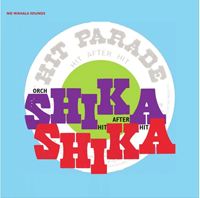
|
ORCH SHIKA SHIKA
HIT AFTER HIT (No Wahala Sounds)
It's odd how music can get under your skin, become more than earworms, turn into an obsession. This, I suppose is why so many of us collect records. In Summer 1983 I was sitting at the bar of Thompson's Falls Lodge, a tourist spot in Kenya, drinking a White Cap. My companions were out hiking around in the heat. Idly sitting there, I saw a hand-written note pinned to the bar: "45s 10/-." This is not new math but a clear indication of a find. I asked, and the barman pulled out a shoebox from under the bar, containing well-worn 45s that were rejects from the jukebox, some having obviously been played to death. "How much for the whole box?" I ventured. Ten shillings each, he replied, unperturbed. So while I nursed my beer to room temperature I explored the contents. First I pulled out all that were in Lingala, then I looked for dance styles I knew such as rumba or cavacha. Shika yeye -- what's that? Then the labels, ASL? sure. TPOK Jazz, have to have that. Sadly I couldn't afford all of them but took a dozen, regardless of condition and the fact the barman was still unwilling to negotiate. I was overlanding, so wouldn't be able to play them for months, but didn't want any more damage, so wrapped them securely and buried them in my backpack.
As you've probably gathered this was one of those watershed moments in my life. One of the most thrashed singles in my trove was "Tika na lela" by Lovy & Orchestre Shika Shika. Behind the layers of snap, crackle and pop lay one of the purest, sweetest ballads ever recorded. (A completely restored version is on the new LP.) And who was this band? I had heard Virunga live in Nairobi and they had a similar vibe. I started searching, pretty much in vain, for information or more from this band. It was not until the advent of [echo voice:] ¡¡¡¡Cyber Space!!!! that my explorations made any headway. I had discovered a genre of music that I decide to call
"Congo in Kenya", created, naturally enough, by expatriate Congolese bands such as Virunga who had relocated to Nairobi. I started trying to plot the movement of the members of these Congolese bands and found threads running through them: this turned into a book-length opus which you can find in the above link. But remarkably, I managed to track down surviving band members. The singers of Shika Shika had all died, but the guitarists were alive and well: one was still in Kenya, one in Canada, and one in... Minneapolis, Minnesota. Through this latter, Siama Matuzungidi, I managed to piece together the story of the band, and their offshoots. This led me to other bands: Moja One, Les Jaca, Bana Moja, Bana Ngenge and on and on. But behind it all was my passion for Shika Shika. I also met a collector with the same bug who somehow had better connections to good copies of the music, but I was not jealous as he was also generous to a fault.
As my webpage grew I thought it might be a good idea to share the music -- not just scratchy MP3s passed from cel phone to cel phone or flung into cyberspace for pirates to gobble up, but properly remastered songs with contextual notes. A friend who is a music copyright lawyer suggested I put together at least ten albums and launch a label. So I started on that project, even made a booklet and a cloth box for the CDs, then Stern's issued their two CDs of Moreno & Moja One, compiled by Doug Paterson, which were far above anything I could muster: he even found brilliant unreleased tracks from master tapes! Well, I thought, it's time to launch Shika Shika on the Muzikifan label. I wrote to the Kenya Musical Rights Society and asked them if they could put me in touch with the heirs of Jim Monimambo, Moreno Batamba or Lovy Longomba. Oh, that's us! they said, You pay us and we will take care of it. Right.
No Wahala Sounds has been issuing some of this Congo in Kenya material on vinyl (Nairobi Calling; Kenya-Congo Connection), and asked me for photos from my webpages. Then they asked about the Shika Shika project. I am thrilled to say this classic album, compiled from 45s on the Hit Parade label, is now out. There are five tracks on here, each is 9 minutes long. They have been restored to crystal clarity by the "Bwana Mkubwa" (big chief) Doug Paterson. "Tika na lela" will leave you weeping. The others will get you onto the dance floor. And then while you are sitting collecting your breath, you can read the breath-taking liner notes by an authority on their music (your humble servant) PLUS, in addition, thanks to my good friend Jerome Ogola, you can also sing along in Lingala and Kiswahili, as well as understand the lyrics, which are presented in English for the monoglot audience. I am thrilled to announce the publication of this album, and hope it's only the first of many more fruitful collaborations. ·
|
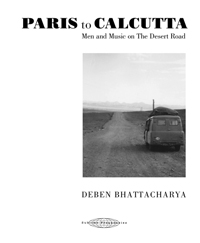
|
DEBEN BHATTACHARYA
PARIS TO CALCUTTA: MEN AND MUSIC ON THE DESERT ROAD (Sublime Frequencies SF112CD)
This 4-CD set and hardback book chronicles a journey made in 1955 when Deben Bhattacharya drove from Europe to his home in India, stopping along the way to record local musicians. Reversing the journey of filmmaker Tony Gatlif's masterpiece Latcho Drom, it shows a kaleidoscopic picture of the Bedouin, gypsies, and other lesser-heard musicians along the route. In 1958 Bhattacharya made an LP compilation (necessarily compressed) from his recordings, but this is the first time the full tapes have been released. In an interview with Guitarist magazine in 1993 Frank Zappa cited that 13-track LP, Music on the Desert Road (Angel Records), with having a huge influence on him. Robert Millis, the man behind Indian Talking Machine, edited the release. Sublime Frequencies, along with Dust-to-Digital, are making considerate and considerable contributions to the preservation of lost treasures of ethnomusicology for future generations.
Deben was a Bengali poet who learned English, Hindi and Sanskrit. He went to England, not for a degree, but to pursue his musical education. He subsequently wrote books about the gypsies and the Bauls, wandering "madmen" singers of Bengal. He promoted Purna Das Baul and the Langa clan of Rajasthan in concert. He was an expert on Indian classical music and in London recorded local Indian performers and sold the recordings to the BBC. With a little capital advanced by EMI for future recordings, his tape recorder and an old Bedford van, he set off overland for home, planning to record Muslim and Hindu music on the way. The driver was a young architect he knew who wanted to go to Chandigarh to meet his hero Le Corbusier (Not surprisingly when they arrived the architect was in ecstasy while Deben was appalled by the Western suburban orderliness of the place and how un-Indian it is). The van was both a home on the road and furthermore the battery could power the reel-to-reel deck. The last disc of recordings in West Bengal are truly lovely.
Outstanding moments are the tar solo by Shapoore Delshadi, recorded in Tehran. Another Iranian, Eskandare Ebrahimi also rips out a stunning improvisation on his setar. Staying in the former British Consulate building in Meshed, Iran, Bhattacharya set up his equipment:
"I had no idea that we would be spending any time in Meshed. But I had got used to changing my plans according to the whims of the road. What else could I do since my mission was to seek for people who improvised music? It always happened that way. If I arrived with letters of introduction, plans, time tables and so on, nothing else would happen. No one would come, not even a braying donkey! Whereas, if I simply arrived, in would come processions of musicians with drums, cymbals, strings, flutes, songs and dances. And as I pushed my battered little microphone right inside their mouths, their songs and dances reverberated through my veins. They sang not only for me but also for the moment which became alive, charged with sound. They improvised and if you were sympathetic, a sharer of sorrow, they expected you to improvise too."
In his career, Deben released over 80 albums of folk music. This distillation gives a taste of the young man embarking on his remarkable journey. ·
|
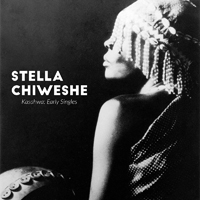
|
STELLA CHIWESHE
KASAHWA: EARLY SINGLES (Glitterbeat GB061CD/LP)
We haven't heard from the Queen of the Mbira in some time. She even put out a "Best of" compilation twenty years ago which usually signals a caesura in an artist's career. But I guess like all of us, she is aging, and taking it easy now she is in her 70s. I was doing pretty well myself until I knackered my lower back (an old complaint) last week. My sweetheart sent me an article which explained how bushmen in Tanzania, the Hazda, one of the last groups of hunter-gathers on earth stay fit because they are foraging for food and not sitting in front of a computer all day. I am not sure what their life expectancy is however, so I am not giving it all up to go to the Serengeti looking for nuts n berries and the odd spearable and roastable small critter (I can't even throw a tennis ball to scare the squirrel who tears up my plants). Bethatasitmay those East African tribes have deep spiritual roots connecting them to the earth and you sense that in ancient music, such as the mbira and rattles heard on this new gathering. If you are sitting in the smoke of a fire listening to this, it could put you in a trance and connect you to the spirits of those animals you long to encounter with your spear and flexible back. The Shona have played this mystical music for over a century, to call out to the spirits of birds, trees, water, even stones and send messages to the guardian spirits in all-night ceremonies. You might glimpse that here, in these eight brief tracks that were released as singles in pre-Mugabe Zimbabwe when it was Rhodesia. Interestingly the rituals associated with this music were forbidden but the recordings were made by Teal Record Co, however they did not actively promote them, so they are very obscure. The title track "Kasahwa" says innermost emotional pain is like a fishbone stuck in the throat. Chiweshe recorded it on a borrowed instrument since none of the instrument makers would make an mbira for a woman. It was an immediate hit and secured her a place in the National Dance Company. Check out her single "Mayaya" here. ·
|
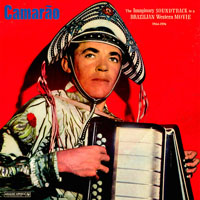
|
CAMARÃO
IMAGINARY SOUNDTRACK TO A BRAZILIAN WESTERN MOVIE (Analog Africa 25)
Samy Ben Redjeb jets off to the Sertão of Northeast Brasil and returns with an invigorating collection of accordeon hits from the decade 1965-75 in a new departure for his groundbreaking label, Analog Africa. He refers to a Western Movie in the title and it's not far-fetched: the deserts of the Nordestino do resemble the wild west and are also full of legendary figures like Lampião, a cross between Robin Hood and Jesse James. Lampião is the subject of folk ballads which are sung and gathered in chapbooks called Livros do Cordel, one of the great surviving folk art forms of South America. Those ballads, a bit like decimas, are hard to take at length, however, unlike the delicious forró which has elements of brass band, with seductive clarinet and exclamatory triangle romping along with accordeon and a resounding bomp on bass drum. I recently had my old dead Mac brought back to life and was to pleased to think most of the acres of lost music files were intact, but when I started digging them out, iTunes had only kept the first track of many albums. In this era of evanescent digital music it's nice to hold the album in your hands, whether you are into vinyl LPs or CDs with a fat booklet to give you the context for the music you are listening to. Young people are getting into books, apparently, so perhaps artifacts are not so obsolete, and while I don't have much faith in the durability of my CD collection, I know where stuff is. Also LP sales are on the rise again, helped along in part by vinyl issues from Analog Africa (not to mention Matsuli, Teranga Beat, Crammed Disc). Drawing from 6 albums released between 1964 and 1974, this disc presents a great selection of quintessential forró music. Camarão started modestly with a triangle and zabumba (bass drum) to accompany his accordeon but his band expanded to include 4 percussionists, 3 saxes, 2 trumpets, 2 trombones, 2 guitars and 2 singers, so he fed a large family in his decade in the spotlight. The various configurations give the compilation depth and variety, and a definitive cinematic flavor: the whole thing is a joyous celebration. · |
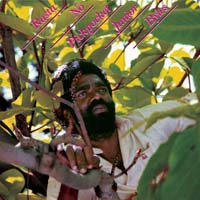
|
JUNIOR BYLES
RASTA NO PICKPOCKET (Omnivore OVCD-286)
I've always felt there are not enough Junior Byles tunes in the world, so was thrilled to receive the latest reissue of Nighthawk Records from Omnivore. Junior's final album, Rasta no pickpocket, from 1986, backed by the legendary Roots Radics and produced by Niney the Observer was sadly only 22 minutes long. It has come around again with enough bonus material to double the length. Byles must have been a fat kid, because he was known as "King Chubby" when he formed a vocal trio called The Versatiles with schoolmates. They had a series of hits working with Lee Perry at Joe Gibbs ("Someone to love," "Lu-lu Bell," "Push it in," "Time has come," "The thanks we get"-- need I go on, or can we just have the definitive compilation? Someone please prod Steve Barrow for me), and then the Versatiles moved to Duke Reid's Treasure Isle. When Bob Marley left Perry's Black Ark, the legendary producer brought in Junior to fill the void as a Rastafarian front man for his sonic experiments with the Upsetters. Six years of this work was distilled into the essential Curly Locks compilation on Heartbeat. From the liner notes it seems the present album was cut in one night in 1986 under difficult circumstances -- in an overcrowded studio with onlookers (rude bwoy gwan mash up da place) creating massive fumes and disruptions. "I don't know" is, to me, the standout track on here. Technology has great potential to take us to space but others are using it to wipe out the human race, he says, getting it off his chest. "Demonstration and protest are pitting brother against brother. I don't know what the world is coming to." Despite my avowed Atheism I appreciate religious sentiments such as "What doth it profit a man to gain the whole world and lose his soul?" Homilies such as this inform the lyrics of Byles. After that there was nearly a decade of relative silence when Byles was homeless or institutionalized. Two of the bonus tracks are songs which Junior fans will have already: "Bur-o-Boy" and "Weeping" appeared on the Trojan compilation When will better come, however there they were shortened by 30 seconds each, so that's a bonus minute. Then there's "This feeling" a welcome new addition to the Byles canon, with conscious lyrics and a solid groove. By the way the two new version sides also show off the talents of the band, comprising Style Scott on drums and Flabba Holt on bass; Bingy Bunny, Chinna and Dwight Pinkney strum the guitars; Steelie and Bubbler pump the keyboards; Bongo Herman, Scully & Sticky ply the percussion, and that leaves the fabulous hornsmen, Tommy McCook, Bobby Ellis & Deadly Headly, to fill any gaps. Classic -- Extra Classic even. ·
|

|
ANGOLAN SAUDADE VOL 1 (Sons d'Afrique)
Angolan music doesn't arrive too often and when it does there is not much fanfare. Also it comes in clumps which is to say you are more likely to encounter a compilation than individual artists. Nevertheless there are many wonderful compilations of Angolan music as I have doubtless said before. My friend Ken alerted me to the latest which is called Saudade, which we tend to think of as sad ballads full of melancholic longing for the lost land that was decimated by decades of civil war. But it's not at all a downer: there are many sprightly tunes on here. You can find this 18 track compilation on line, on your favorite download site, but you won't find any liner notes, merely the names of the artists and the song titles. This is the current trend and it doesn't help reviewers or those trying to get a handle on the context of the music, especially if their Portuguese is limited to "obrigado" and "o meu amor." From the general sound I would guess this music comes from the mid-70s, and the consistent high quality suggests that Os Jovens do Prenda, the main backing band of that era, play on a lot of these tracks. It's a well-put together compilation and does not overlap with either Soul of Angola or the two volumes of Angola 70's, that appeared on Lusafrica and Buda respectively. The storming "Pachanga Maria" by Os Bongos and "Comboio" by Kiezos did appear on Analog Africa's Angola Soundtrack 1 which was thoroughly annotated. We learn there that both tracks were issued on Rebita Records in 1974; Rebita issued hundreds of records before the start of the civil war in 1975. Diminishing returns has not set in to this old music, and it seems that, once again, here is a rich vein of relatively unknown music still turning up gold nuggets.
|

